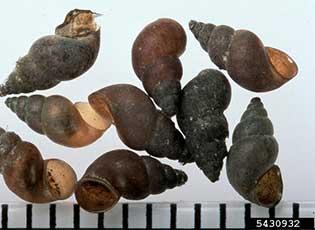Potamopyrgus antipodarum (J. E. Gray, 1853) (ITIS)
New Zealand mud snail (NZMS), Jenkin's spire shell
Hydrobia jenkinsi (Smith E. A., 1884), Potamopyrgus jenkinsi (Smith, 1889) (CABI)
New Zealand (NAS Database)
First discovered in Idaho in 1987 (NAS Database)
Unknown; possibly through ballast water or game fish imports (Zaranko et al. 1997; NAS Database)
Unknown; may displace and compete with native invertebrates (NAS Database)
West Coast; Great Lakes; Chesapeake Bay

New Zealand mud snails
Photo by Mike Gangloff
Spotlights
Distribution / Maps / Survey Status
All Resources
Selected Resources
The section below contains highly relevant resources for this species, organized by source.
Council or Task Force
Partnership
Federal Government
State and Local Government
CABI. Invasive Species Compendium. Potamopyrgus antipodarum. CAB International. [Accessed Aug 10, 2023].
Integrated Taxonomic Information System. Potamopyrgus antipodarum. [Accessed Aug 10, 2023].
Nonindigenous Aquatic Species Database. Fact Sheet - New Zealand Mudsnail. USGS, Gainesville, FL. [Accessed Aug 10, 2023].
Zaranko, D.T., D.G. Farara, and F.G. Thompson. 1997. Another exotic mollusc in the Laurentian Great Lakes: the New Zealand native Potamopyrgus antipodarum (Gray 1843) (Gastropoda, Hydrobiidae). Canadian Journal of Fisheries and Aquatic Sciences 54(4):809-814.
